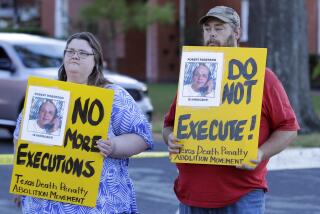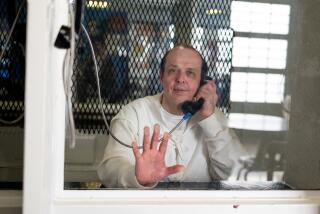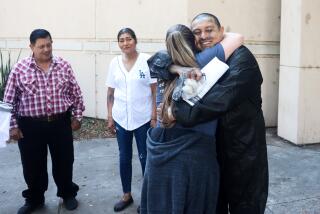Shaken-baby syndrome is questioned
- Share via
When 7-month-old Natalie Beard’s body arrived in the autopsy room, there were no outward signs of physical abuse. No broken bones, bruises or abrasions.
But behind her pretty brown eyes and beneath her fine dark-brown hair, there was chaos.
Both retinas were puckered and clouded red. There was acute bleeding outside and beneath the brain’s outer membrane -- the kind of bleeding most often associated with a burst aneurysm.
To forensic experts, these were classic signs that Natalie had been shaken to death.
The common wisdom in such “shaken-baby” cases was that the last person with the child before symptoms appeared was the guilty party. A Wisconsin jury convicted baby-sitter Audrey Edmunds of first-degree reckless homicide.
Edmunds is 10 years into her 18-year prison sentence, and she’s seeking a new trial.
In the decade since her conviction, her attorneys say, many experts have studied the physics and biomechanics of shaken-baby syndrome and concluded that shaking alone could not have produced Natalie’s injuries without leaving other evidence of abuse.
Among those questioning the diagnosis is Dr. Robert Huntington III, the forensic pathologist who examined Natalie’s body and whose testimony helped put Edmunds away.
If the trial were held today, Huntington told the Associated Press recently, “I’d say she died of a head injury, and I don’t know when it happened.... There’s room for reasonable doubt.”
Some judges in other cases have broadly agreed.
Last year, a judge in Manatee County, Fla., barred use of the term “shaken-baby syndrome” because of its possible prejudicial influence on jurors.
A Kentucky judge subjected shaken-baby to a “Daubert” test -- a kind of mini-trial to determine the validity and admissibility of certain evidence. Circuit Judge Lewis Nicholls decided he could not admit expert testimony on a theory whose foundation may amount to “merely educated guesses” about the cause of death.
“The best the court can conclude is that the theory of SBS is currently being tested, yet the theory has not reached acceptance in the scientific community,” Nicholls ruled.
But the syndrome does not lack official recognition.
“Shaken-baby syndrome is a serious and clearly definable form of child abuse,” the American Academy of Pediatrics declares on its website.
According to the National Institute of Neurological Disorders and Stroke, shaken-baby syndrome bears a “classic triad” of signs -- brain hemorrhaging, retinal hemorrhaging and brain swelling. Because of a baby’s relatively heavy head and weak neck muscles, shaking “makes the fragile brain bounce back and forth inside the skull and causes bruising, swelling, and bleeding, which can lead to permanent, severe brain damage or death,” the institute says.
An estimated 1,500 shaken-baby cases were reported in the United States last year, says Toni Blake, a San Diego defense attorney who specializes in the cases.
But 3 1/2 decades after the term was first used, there seems to be no middle ground in the debate.
The syndrome “doesn’t exist,” contends Dr. John Plunkett, a Minnesota pathologist who began openly questioning shaken-baby syndrome after the 1997 involuntary manslaughter conviction of British nanny Louise Woodward, the case that put the syndrome on the map. “You can’t cause the injuries said to be caused by shaking, by shaking.”
Many pediatricians disagree.
“People confess to it. So it has to be possible,” counters Dr. Suzanne Starling, director of forensic pediatrics at Children’s Hospital of the King’s Daughters in Norfolk, Va.
She and her colleagues analyzed 81 cases in which an adult confessed to shaking and/or battering a child. In cases where only shaking was admitted, the children were 2.39 times more likely to have retinal hemorrhages than victims of impact alone, they found, “suggesting that shaking is more likely to cause retinal hemorrhages than impact.”
Plunkett scoffs: “What is the No. 2 cause of wrongful convictions? False confessions. ... You don’t base scientific conclusions on what people confess to.”
Dr. Robert Reece, a Boston pediatrician, is on the international advisory board of the National Center on Shaken Baby Syndrome, but he avoids using the term in a courtroom. “What goes on in the courtroom is up or down, and medicine doesn’t work that way usually,” he says.
In testimony, he refers to “abusive head trauma” or “inflicted traumatic brain injury,” though he still believes shaking alone can cause it.
Research is split:
* Plunkett, in a 2001 article, concluded that an infant could suffer a fatal head injury from even a short fall, and that the injury “may be associated with a lucid interval and bilateral retinal hemorrhage.” In other words, symptoms might not immediately follow the injury -- which can be an important issue in fixing blame. In addition, there were other, accidental sources for one of the “classic” signs of shaken-baby syndrome, he wrote in the American Journal of Forensic Medicine & Pathology.
* In a 2003 study, University of Pennsylvania researchers used special dummies to simulate a 1 1/2 -month-old baby being shaken or dropped from various heights. The response to a vigorous shaking was “statistically similar” to that from a 1-foot fall onto concrete or concrete with carpet pad, they found; a fall from 3 feet produced forces nearly 40 times greater.
* But still-to-be published research using a more advanced infant dummy simulated far greater brain damage than with previous dummies, says Dr. Carole Jenny, a Brown University Medical School professor and chairwoman of the American Academy of Pediatrics’ committee on child abuse and neglect.
“They come into court and they say, ‘Oh, you can’t kill a baby just by shaking it,’ and yet they have a dead baby before them,” she says. “Did a flying saucer come in from Mars and strike the baby in the head?”
* Other studies cited by shaken-baby syndrome opponents have suggested that the hemorrhaging and swelling thought to prove shaking can have myriad causes, including dehydration, infection and oxygen deficiency.
Much of the debate has centered on how quickly symptoms begin after a brain trauma. That question was central to the Wisconsin case.
On Oct. 16, 1995, Edmunds was caring for her two daughters and another child when Cindy Beard dropped off her daughter, Natalie.
Natalie had had an ear infection and had vomited in recent days, but her parents say that appeared to have cleared up. But Edmunds says Natalie was unusually fussy that morning and refused to take a bottle.
Edmunds, who was five months pregnant with her third daughter, says she put Natalie down with a propped bottle and went to tend to the other children. When she went back to retrieve Natalie, the girl was crying and limp, her face slick with regurgitated formula.
At her 1996 trial, Huntington testified it was “highly probable” that Natalie was injured within two hours of being treated. That would mean the fatal injury occurred while Natalie was in Edmunds’ care.
What changed his mind was a later case involving a child with injuries similar to Natalie’s. That child had a “lucid interval” of more than 15 hours before the onset of symptoms, leading Huntington to acknowledge that Natalie could have been injured long before she was dropped off at Edmunds’ house.
Edmunds’ attorney cited other studies in which there were lucid intervals of 24 hours between injury and death.
George Nichols, a former Kentucky medical examiner, testified recently on Edmunds’ new trial request. It was his conclusion that Natalie had some kind of choking event, and that a lack of oxygen to the brain resulted in fatal brain injury.
Prosecutors dismissed Plunkett, Nichols and others as “a fringe group of doctors.”
Dr. Thomas L. Bohan, a forensic physicist and attorney, has tried to get the National Academy of Sciences and the National Institute of Justice to evaluate the medical and legal arguments.
Bohan, vice president of the American Academy of Forensic Sciences, says it’s not good enough to say you can’t really study shaken-baby because you can’t shake actual babies to test the hypothesis.
“The point is, you don’t send people off to prison for 50 years and break up families because you don’t want to do the work to validate it,” Bohan says.
Audrey Edmunds was hoping that science would set her free.
About once a month, the 45-year-old mother and her daughters visit in the prison cafeteria. They talk on the phone several times a week.
“I’ve lost a part of their life,” says Edmunds, whose husband divorced her several years ago because he couldn’t wait any longer. “But there’s a lot that we stay strong with too.”
In late March, a judge ruled on Edmunds’ motion for a new trial. Her witnesses and newly discovered medical evidence, although strong, did not outweigh trial evidence, he ruled.
Motion denied.
Her attorney has filed a notice of appeal. In the meantime, Edmunds has a parole hearing in October. The board has already turned her down three times.






